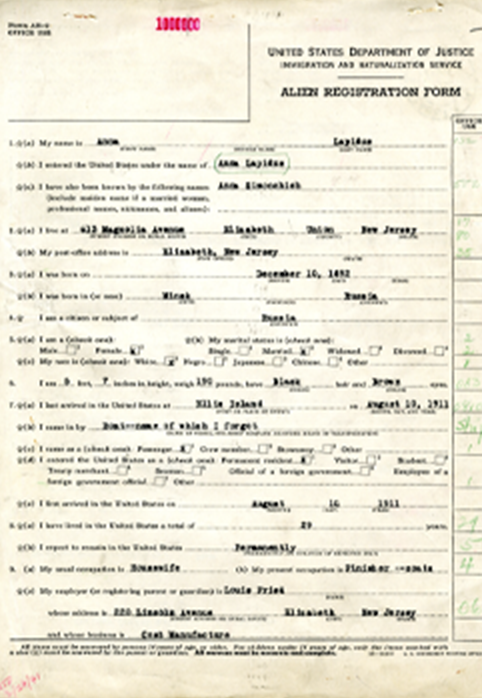A-File #1 (Million): The first A-File?
Most immigrants and their families today are familiar with the A-File system. A-Files are used to document noncitizens’ interactions with USCIS, Customs and Border Protection, and Immigration and Customs Enforcement. They include all an individual’s official immigration and naturalization records and are identified by a unique A-Number. A-Files are central to our agency’s daily operations and play a key role in adjudicating immigration benefits and supporting enforcement actions. Today, USCIS maintains millions of A-Files, both in paper and digital format.
The Immigration and Naturalization Service (INS), the precursor to USCIS, created the first A-File on April 1, 1944. The A-File’s history, however, can be traced back to the Alien Registration Act of 1940.*
In response to the outbreak of World War II and the general lack of information about the nation’s immigrant population, Congress passed a law that required all noncitizens age 14 years and older who planned to be in the U.S. for more than 30 days to register with the INS. Noncitizens already in the country went to their local post office, where they filled out a registration form and provided fingerprints. Newly arriving immigrants completed their registration forms when they received their visas. The forms were sent to the INS, where they were coded, used to generate statistics on the country’s immigrant population, and filed.
Importantly, the INS also stamped each form with a registration number and sent each registered noncitizen a corresponding registration card, which could be used as proof of registration. Over time, what contemporaries called the “Alien Registration Number” became known as the “A-Number.”

INS decided to start the sequence of A-Numbers at 1 million, rather than one. Presumably, A-Number 1000000 was issued to the first noncitizen registration the agency processed. That registration belonged to Anna Lapidus, a 48-year-old immigrant from Russia who lived in Elizabeth, New Jersey, and worked in the garment industry.
In 1940, Anna—like millions of other noncitizens who registered—received an A-Number, but she did not have an A-File. It took the INS four more years to develop the A-File system.
After World War II, INS officials decided they needed to rein-in their record keeping systems. The agency held more than 300,000 cubic feet of files, which were divided over more than 20 file systems. In addition to the cost associated with storing and moving so many records, INS faced the inefficiency of having to search multiple indices and files to find all the records for a single immigrant.
To help solve the space and cost issues, INS began an aggressive program of microfilming many older records and identifying others for transfer to the National Archives. To address the problems associated with having multiple files for a single immigrant, INS decided to switch from an action-based records system to an individual-based records system.
That is, rather than opening a new file for each action the immigrant took (such as applying for a visa and filing a naturalization application), the agency would open one file for each immigrant and place all their paperwork in that file. As a result, employees could search for just one file, greatly reducing the time and effort required to locate records.
The A-Number proved crucial to this new system. It became the unique identifier assigned to the new individual-based files, which became known as “A-Files.” INS switched to the A-File system on April 1, 1944.
After that date, new immigrants received an A-File which held all their records. Immigrants already in the country who had registered under the Alien Registration Act were issued A-Files under their registration numbers upon their next interaction with the INS. For example, an immigrant who registered in 1940 and then applied for a benefit in 1945 received an A-File upon filing the 1945 application. In most of these cases, INS consolidated the immigrant’s earlier files under the new A-File.
USCIS continues to innovate on the system INS initiated in 1944 with hybrid and electronic records, which are more secure, less expensive to store, and easier to track than their paper counterparts. The individual-based records philosophy also remains a priority, now called person-centricity. The development of innovative systems such as Person-Centric Identity Services (PCIS) enhances case processing and improves data integrity by integrating and analyzing many information sources into a consolidated view, thereby streamlining research, identifying discrepant data, and emphasizing an individual’s current status and address in a user-friendly way.
In Anna Lapidus’s case, A-File consolidation occurred in 1951, when she submitted her Alien Address Report to INS. Upon its receipt, INS combined it with her Alien Registration record and created A-File 1000000. So, although A-1000000 is the “first” A-File sequentially, it was not created until seven years after INS issued the first A-Files in 1944.
Unfortunately, we know very little about Anna Lapidus beyond the information provided on her registration record. According to census records, she and her husband Samuel raised a family in Elizabeth while she continued to work in the garment industry for several years. She appears not to have naturalized. She passed away in 1974. In USCIS history, she bears the distinction of having the first A-File.
*Note: USCIS does not use the term “alien” to refer to noncitizens in the United States. This article uses it when referring to specific names of laws, forms, and events, as used by people in the past.

